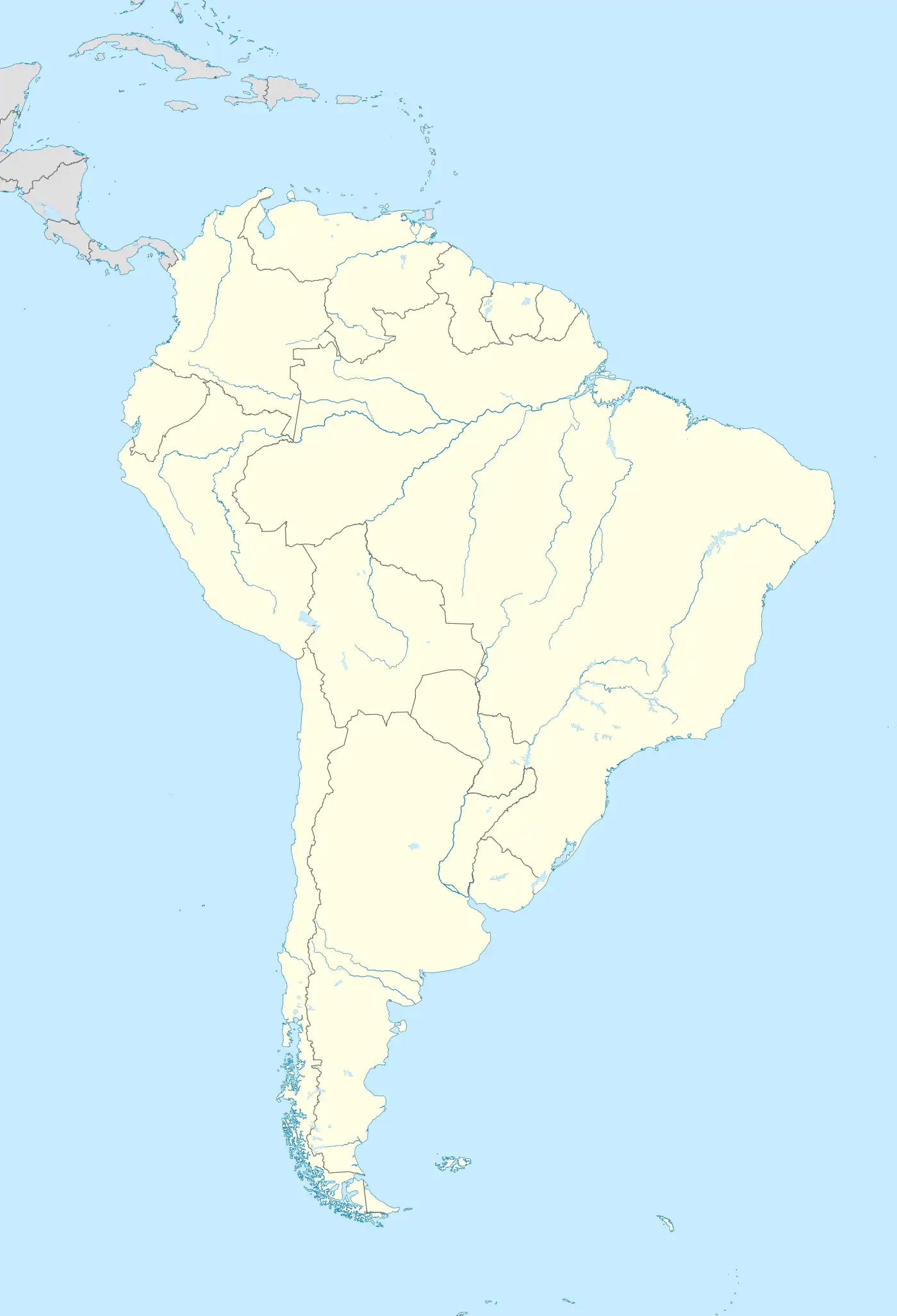Cancun International Airport Aeropuerto Internacional de Cancún | |||||||||||||||
|---|---|---|---|---|---|---|---|---|---|---|---|---|---|---|---|
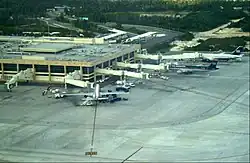 | |||||||||||||||
| Summary | |||||||||||||||
| Airport type | Public | ||||||||||||||
| Operator | Grupo Aeroportuario del Sureste | ||||||||||||||
| Serves | Cancún, Quintana Roo, Mexico | ||||||||||||||
| Location | Benito Juárez, Quintana Roo, Mexico | ||||||||||||||
| Opened | 1975 | ||||||||||||||
| Hub for | VivaAerobus | ||||||||||||||
| Focus city for | Volaris Magnicharters | ||||||||||||||
| Time zone | EST (UTC-05:00) | ||||||||||||||
| Elevation AMSL | 6 m / 20 ft | ||||||||||||||
| Coordinates | 21°02′12″N 86°52′37″W / 21.03667°N 86.87694°W | ||||||||||||||
| Website | www | ||||||||||||||
| Map | |||||||||||||||
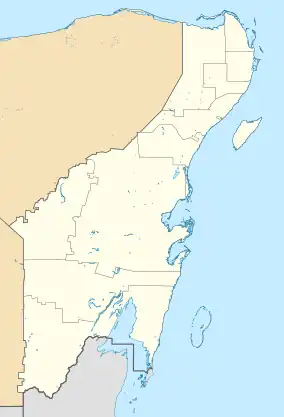 CUN Location of the airport in Quintana Roo 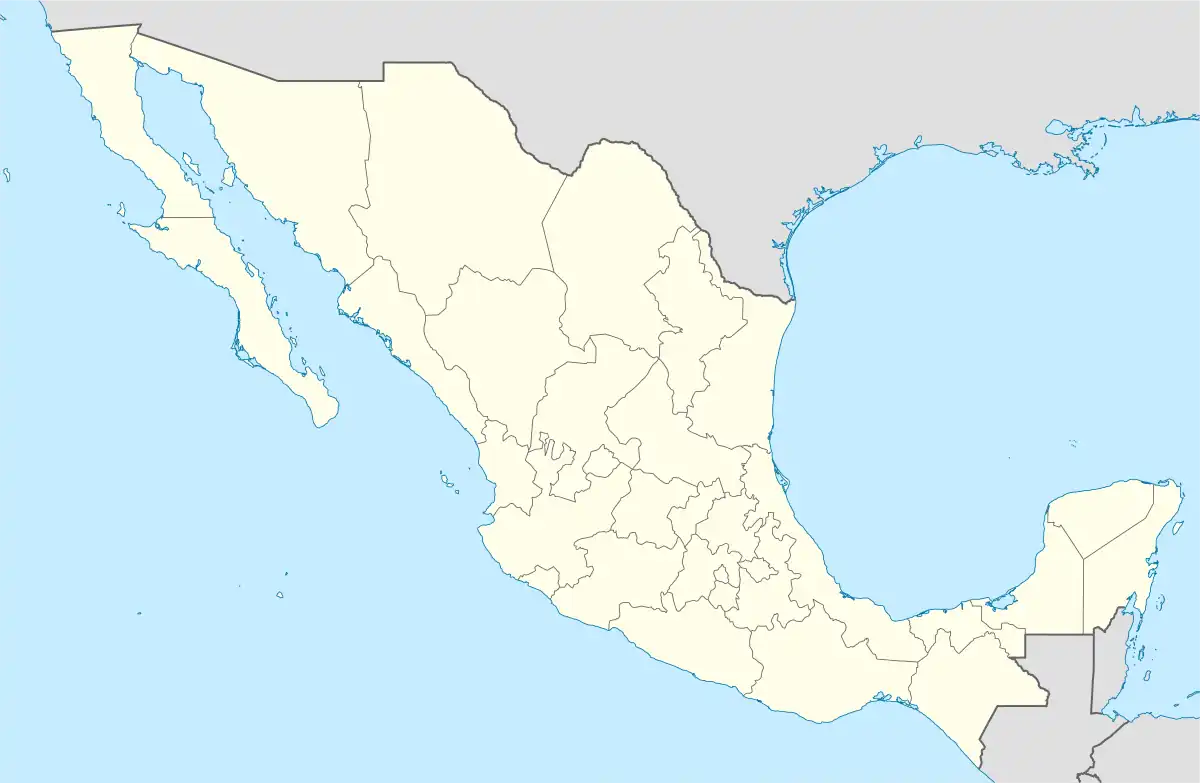 CUN CUN (Mexico) | |||||||||||||||
| Runways | |||||||||||||||
| |||||||||||||||
| Statistics (2022) | |||||||||||||||
| |||||||||||||||
Source: Grupo Aeroportuario del Sureste[1] | |||||||||||||||
Cancún International Airport (Spanish: Aeropuerto Internacional de Cancún) (IATA: CUN, ICAO: MMUN) serves as the primary gateway for the Cancún Metropolitan Area in Quintana Roo, the Mexican Caribbean, Riviera Maya, and Yucatán Peninsula. Operating as a hub for VivaAerobus and a focus city for Volaris and Magnicharters, it facilitates flights to major cities across Mexico. The airport is managed by Grupo Aeroportuario del Sureste (ASUR).
It is the largest airport in Mexico and Latin America in terms of international passengers, representing 35% of all international passengers in the country. Offering flights to over 100 cities across 30 countries in the Americas and Europe, Cancún Airport is served by most U.S. and Canadian mainline airlines from all their hubs and focus cities, making it the airport outside the United States with the highest number of passengers to and from the United States.[2]
In addition to its commercial operations, Cancún Airport supports various activities in general and executive aviation, flight training, and intensive air charter services. Cozumel and Tulum international airports serve as alternative options in the Cancun area, contributing to the region's overall aviation infrastructure.
Ranked as the 43rd busiest airport in the world, Cancun Airport is Mexico's second busiest, following Mexico City International Airport.[3] Regionally, it stands as Latin America's third busiest and North America's 23rd busiest airport. In 2021, it handled 22,318,467 passengers, witnessing a significant increase to 30,342,961 passengers in 2022.[1]
History
Early operations
Cancun's initial airport was established in 1942 as a strategic move to support the region's primary industry at the time: the chewing gum industry. This early airport operated on a rudimentary runway, featuring a control tower constructed from wood and palm materials, which remained in operation until 1973. To commemorate its history, a replica stands near the city's entrance, close to its original location.[4]
In the early 1970s, Cancun emerged as a major tourist destination following a deliberate effort by the Mexican government, in collaboration with the National Tourism Development Fund (Spanish: Fondo Nacional de Fomento al Turismo) (FONATUR)). Recognizing its strategic location, near pristine beaches, natural landscapes, and archaeological sites, the comprehensive plan aimed to transform Cancun from a sparsely inhabited area into a world-class tourist hub. Substantial investments in infrastructure were made, including the construction of the new Cancun International Airport, executed by Henro y Asociados in collaboration with the Department of Infrastructure. The airport's inaugural commercial flight occurred on May 12, 1975, drawing swift attention from international tourists.
Throughout its history, Cancun Airport has hosted a variety of airlines. It served as a hub for Mexicana, Interjet, and Aladia in their operational years, facilitating connections for both domestic and international flights. Additionally, the defunct charter airline Aerocancun, based in Cancún, provided flights to U.S., Canadian, European, and South American destinations. MAYAir, established in 1994 initially as a charter airline, expanded its routes from Cancun to various destinations in the Yucatan Peninsula.
Privatization and expansion
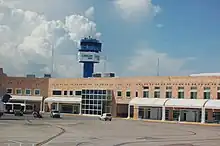
In 1995, Mexico embarked on a significant airport privatization initiative through the 'Ley de Aeropuertos' (Airports Law) introduced by the Department of Communications and Transportation. This marked a pivotal moment for Cancun Airport, integrating it into the Grupo Aeroportuario del Sureste.
Until the early 2000s, Cancun Airport operated with two terminals. A major transformation began in 2005 when ASUR invested US$150 million in constructing Terminal 3, officially inaugurated in 2007.[5] Key additions, including a new runway and Latin America's tallest control tower at 97 meters, were unveiled in October 2009, effectively doubling the airport's passenger handling capacity.[6] On November 27, 2013, Cancun Airport achieved another milestone, becoming the first in Mexico to welcome the Airbus A380, commemorating the 80th anniversary of Air France and the 15th anniversary of ASUR.
The expansion continued with Terminal 2 in 2014, and a significant 76,000 square metres (820,000 sq ft)expansion of Terminal 3 in 2016, introducing six gates and additional commercial areas.[7] This expansion aimed at accommodating the growing annual capacity, increasing it to 10 million from the previous 6 million. Responding to overcrowding and surging demand, Terminal 4 was inaugurated in October 2017.
Despite the challenges posed by the COVID-19 pandemic, Mexican authorities maintained open borders for tourism, positioning Cancun as one of the select international destinations to welcome visitors. In 2021, the airport secured a global ranking of 10th in terms of international passenger numbers.[8]
Facilities
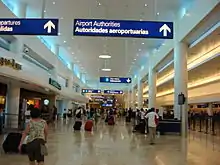
The airport is located in the Cancún urban area, less than 10 kilometres (6.2 mi) southwest of the tourist complex, at an elevation of 6 metres (20 ft) above sea level. It features two runways: Runway 12R/30L, measuring 3,500 metres (11,500 ft) in length, and Runway 12L/30R, spanning 2,800 metres (9,200 ft). With the capability to accommodate large aircraft such as Boeing 747s and Airbus A380s, the airport boasts two parallel operative runways that can be used simultaneously. It holds the distinction of being the easternmost airport in Mexico.
Comprising four terminals, three of which are currently operational, the airport includes an FBO (Fixed-Base Operator) terminal catering to general aviation from Mexico, the United States, and Latin America. Positioned northwest of the airfield, adjacent to Terminal 1, the FBO provides an array of services, including ground support, fuel coordination, ground transportation, car rentals, catering, and various amenities for private and general aviation.
In addition to the terminals, the airport features long-term and short-term parking lots, hotels, restaurants, and rental car services on its grounds. It also accommodates facilities for the Mexican Airspace Navigation Services (Spanish: Servicios a la Navegación en el Espacio Aéreo Mexicano). Future plans include the integration of a station for the Maya Train, connecting the train route with the airport, the city of Cancun, and other tourist destinations in Yucatán.[9]
Terminals
Terminal 1 (only charter)
Exclusively dedicated to charter or private flights, Terminal 1 features 7 gates numbered 1 to 7, 3 helicopter stands, and a VIP lounge, offering comprehensive services for private air travel. Temporarily closed for reconstruction after Hurricane Wilma, the terminal resumed operations exclusively for charter flights upon reopening in November 2013.
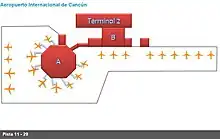
Terminal 2
As the oldest terminal, Terminal 2 accommodates both arrival and departure services for domestic and international flights. With 22 gates—A1 through A11 (in a satellite building) and B12 through B22 (at the main building)—it serves most domestic airlines, along with all international flights to Central and South America and select long-haul flights to Europe. The check-in area houses a bank and food outlets, while the boarding area features several restaurants and shops, along with immigration/customs services. Two lounges, the MERA Business Lounge and The Lounge by Global Lounge Network, cater to domestic and international travellers.
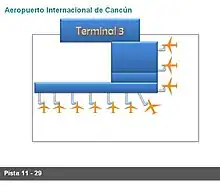
Terminal 3
Exclusively dedicated to international flights, Terminal 3 has 21 gates (C4 through C24) and has recently undergone expansion. This terminal is used by most US carriers, as well as some Canadian and European carriers. It offers shops, including duty-free options, cafés, restaurants, and immigration/customs services. Terminal 3 houses the MERA Business Lounge.
Terminal 4


Terminal 4 serves both domestic and international flights. It has 12 gates and opened in October 2017. This made Cancún International the first airport in Mexico to have four terminals. It is able to handle 9 million passengers a year.[10] Airlines flying to Terminal 4 include Aeroméxico, Air France, Lufthansa, Air Transat, WestJet, Condor, Southwest Airlines, Air Europa, Frontier Airlines, Sun Country Airlines and JetBlue.[11] An on-site hotel is also planned to be opened, as well as a parking structure. Three lounges serve Terminal 4. They are the MERA Business Lounge (national), MERA Business Lounge (international), and The Lounge in Partnership with Air Transat.
Airlines and destinations
Passenger
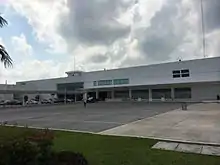

- Notes
^1 TUI fly Belgium's flight from Brussels to Cancún makes a stop in Havana; however, the airline does not have traffic rights from Havana to Cancún.
^2 Turkish Airlines's flight from Istanbul to Cancún makes a stop in Mexico City; however, the airline does not have local traffic rights from Mexico City to Cancún.
Cargo
| Airlines | Destinations |
|---|---|
| Amerijet International | Belize City, Ciudad del Carmen, Mérida, Miami |
| Estafeta Carga Aérea | Mérida, Miami |
| FedEx Express | Mérida, Miami |
Destination maps
 Cancún Domestic destinations from Cancún International Airport Red = Year-round destination Blue = Future destination Green = Seasonal destination Grey = Charter destination |
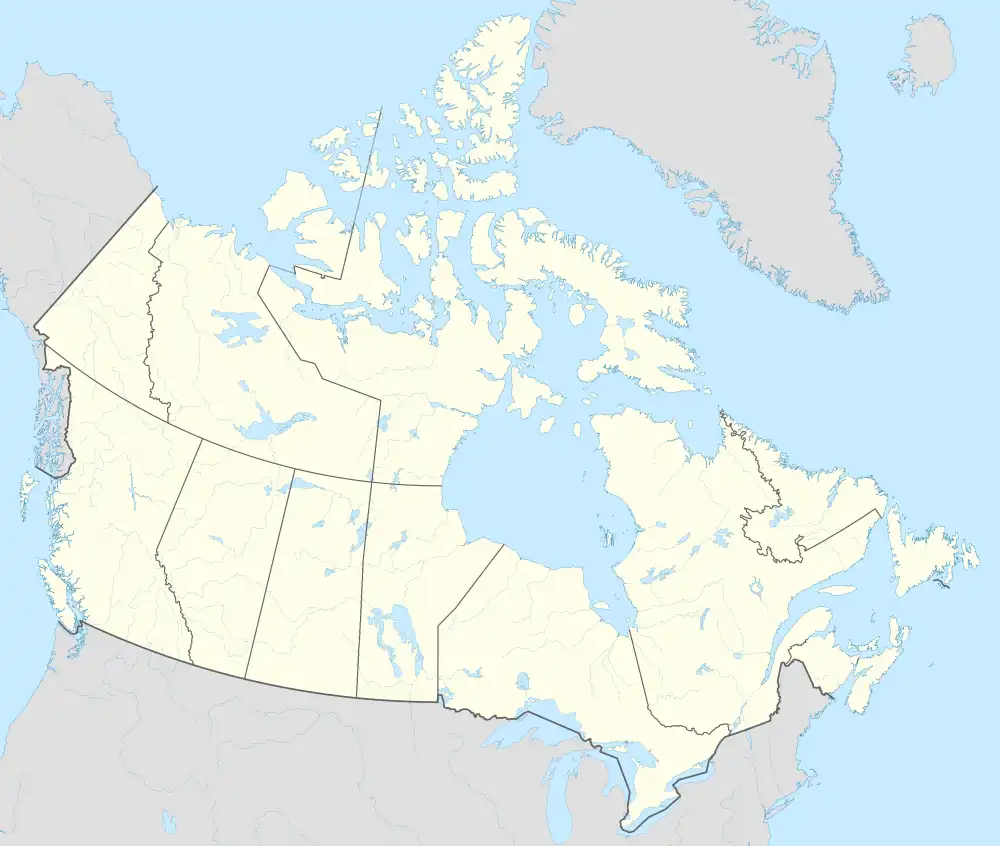 Canadian destinations from Cancún International Airport Red = Year-round destination Blue = Future destination Green = Seasonal destination |
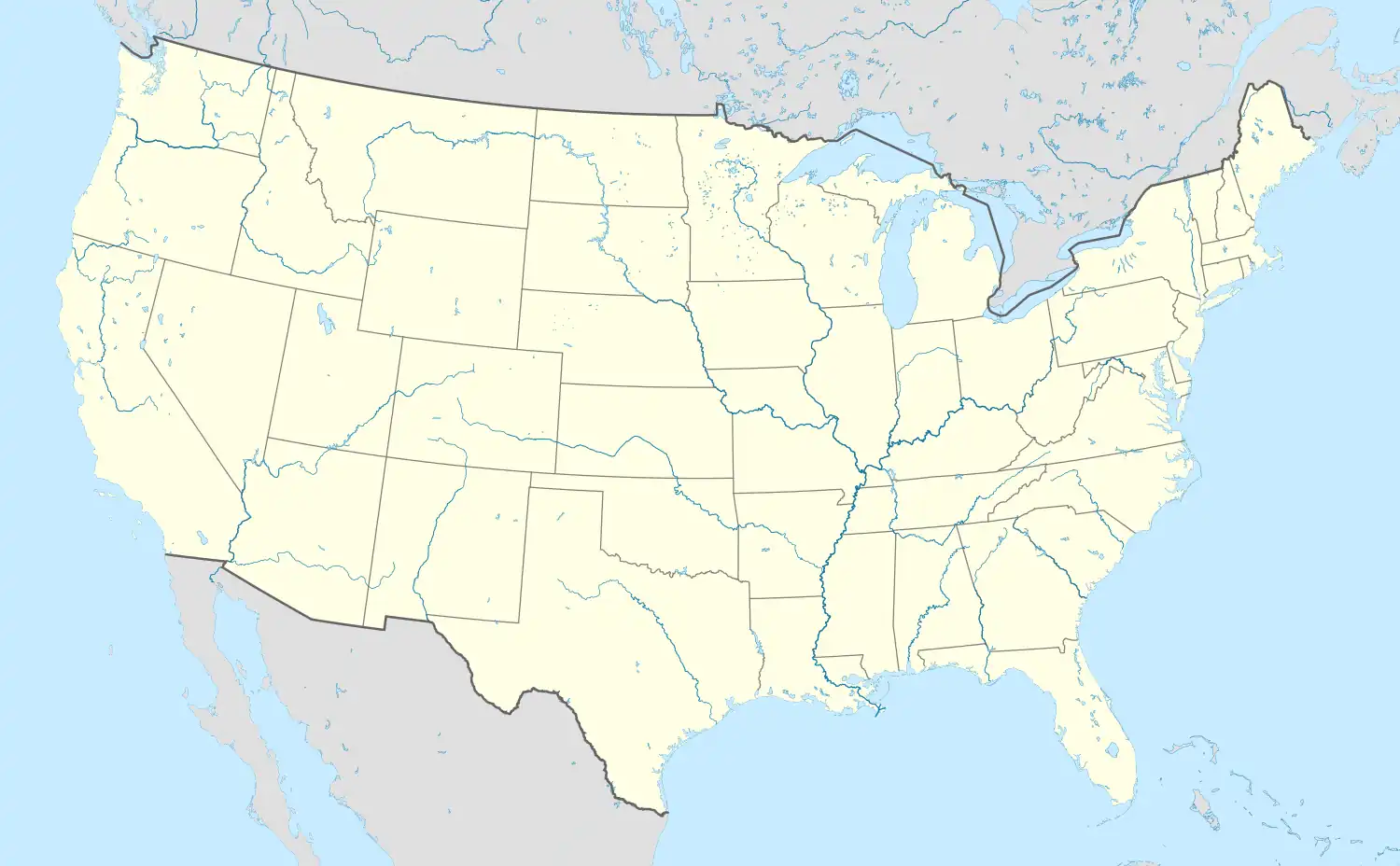 US destinations from Cancún International Airport Red = Year-round destination Blue = Future destination Green = Seasonal destination Grey = Charter destination |
 Cancún Central American and Caribbean destinations from Cancún International Airport Red = Year-round destination Blue = Future destination Green = Seasonal destination |
South American destinations from Cancún International Airport Red = Year-round destination Blue = Future destination Green = Seasonal destination |
 European destinations from Cancún International Airport Red = Year-round destination Blue = Future destination Green = Seasonal destination Grey = Charter destination |
Traffic statistics
Passengers
| Year | Total passengers | % change |
|---|---|---|
| 1999 | 6,969,733 | – |
| 2000 | 7,745,317 | |
| 2001 | 7,639,021 | |
| 2002 | 7,717,144 | |
| 2003 | 8,683,950 | |
| 2004 | 10,010,526 | |
| 2005 | 9,301,240 | |
| 2006 | 9,728,149 | |
| 2007 | 11,340,027 | |
| 2008 | 12,646,451 | |
| 2009 | 11,174,908 | |
| 2010 | 12,439,266 | |
| 2011 | 13,022,481 | |
| 2012 | 14,463,435 | |
| 2013 | 15,962,162 | |
| 2014 | 17,455,353 | |
| 2015 | 19,596,485 | |
| 2016 | 21,415,795 | |
| 2017 | 23,601,509 | |
| 2018 | 25,202,016 | |
| 2019 | 25,481,989 | |
| 2020 | 12,259,148 | |
| 2021 | 22,318,467 | |
| 2022 | 30,342,961 | |
Busiest routes
| Rank | City | Passengers | YoY % change | Ranking | Airlines |
|---|---|---|---|---|---|
| 1 | Mexico City | 4,803,489 | Aeroméxico, Aeroméxico Connect, Magnicharters, Viva Aerobus, Volaris | ||
| 2 | Monterrey | 1,650,289 | Magnicharters, Viva Aerobus, Volaris | ||
| 3 | Guadalajara | 1,027,505 | Magnicharters, Viva Aerobus, Volaris | ||
| 4 | Tijuana | 447,420 | Viva Aerobus, Volaris | ||
| 5 | León/El Bajío | 321,423 | Magnicharters, Viva Aerobus, Volaris | ||
| 6 | Puebla | 311,348 | Magnicharters, Viva Aerobus, Volaris | ||
| 7 | Mexico City – AIFA | 239,813 | NA | NA | Aeroméxico, Viva Aerobus, Volaris |
| 8 | Veracruz | 228,800 | Viva Aerobus | ||
| 9 | Querétaro | 225,337 | Magnicharters, Viva Aerobus, Volaris | ||
| 10 | Ciudad Juárez | 221,533 | Viva Aerobus, Volaris |
| Rank | City | Passengers | YoY % change | Ranking | Airlines |
|---|---|---|---|---|---|
| 1 | Dallas/Fort Worth, USA | 1,216,860 | American Airlines, Spirit, Sun Country | ||
| 2 | Houston, USA[Notes 1] | 1,112,498 | Frontier, Southwest, Spirit, Sun Country, United Airlines | ||
| 3 | Chicago, USA[Notes 2] | 993,998 | American Airlines, Frontier, Southwest, Spirit, United Airlines | ||
| 4 | Atlanta, USA | 760,622 | Delta Air Lines, Frontier | ||
| 5 | Panama City – Tocumen, Panama | 738,972 | Copa Airlines | ||
| 6 | New York – JFK, USA | 686,608 | American Airlines, Delta Air Lines, JetBlue | ||
| 7 | Miami, USA | 642,021 | American Airlines | ||
| 8 | Denver, USA | 622,637 | Frontier, Southwest, United Airlines | ||
| 9 | Los Angeles, USA | 573,596 | Alaska, American Airlines, Delta Air Lines, JetBlue, United Airlines | ||
| 10 | Bogotá, Colombia | 549,313 | Avianca, Viva Aerobus, Volaris, Wingo |
- Note
Accidents and incidents
- On March 15, 1984, Aerocozumel Flight 261 crashed soon after takeoff. No one died in the crash, but one passenger died of a heart attack while evacuating the swampy crash scene.[21]
- On September 9, 2009, Mexico City-bound Aeroméxico Flight 576 was hijacked after take off. The hijackers were Bolivians who wanted to speak to the President. The plane landed safely in Mexico City, and the hijackers were arrested. [22]
Accolades
- 2011 – Best Airport in Latin America – Caribbean of the Airport Service Quality Awards by Airports Council International[23] and 2nd Best Airport by Size in the 5 to 15 million passenger category[24]
See also
- List of busiest airports by passenger traffic
- List of the busiest airports in Mexico
- List of airports in Mexico
- List of airports by ICAO code: M
- List of busiest airports in North America
- List of the busiest airports in Latin America
- Transportation in Mexico
- Tourism in Mexico
- Grupo Aeroportuario del Sureste
- List of beaches in Mexico
- List of cities by international visitors
- Riviera Maya
- Isla Mujeres
- Caribbean Sea
- Tren Maya
References
- 1 2 3 "Passenger's Traffic" (in Spanish). ASUR. Retrieved January 11, 2023.
- ↑ "Cancun passes 30 million passengers in 2022; new records for both domestic and international traffic".
- ↑ "Statistics by Airport" (Web). Secretaría de Comunicaciones y Transportes. Retrieved January 29, 2021.
- ↑ "History". Cancun Online Community. August 2016. Archived from the original on August 9, 2016. Retrieved August 14, 2016.
- ↑ "Inaugurated Terminal 3 of Cancún Airport (in Spanish)". Periódico El Economista. March 2016. Archived from the original on May 31, 2016. Retrieved August 17, 2016.
- ↑ "Cancun opens second runway as traffic grows 30% in two years; US routes lead way". anna.aero. October 2009. Archived from the original on September 20, 2016. Retrieved August 17, 2016.
- ↑ "Third Quarter 2014 Earnings Call Transcript" (PDF). Aeropuertos del Sureste. October 2014. Archived (PDF) from the original on March 5, 2016. Retrieved August 17, 2016.
- ↑ "How Cancun Airport Became The World's 10th Busiest International Airport".
- ↑ "Cancun Airport's Link to Maya Train: Construction Set to Start Soon".
- ↑ "theyucatantimes.com – Cancun airport's new 4th terminal will open Oct. 10". October 5, 2017. Archived from the original on November 16, 2017. Retrieved November 16, 2017.
- ↑ "Cancun Airport Terminal 4". Archived from the original on November 16, 2017. Retrieved November 16, 2017.
- 1 2 "White sand and warm weather: American Airlines announces largest-ever winter schedule to the Caribbean and Latin America". American Airlines Newsroom. June 2023. Retrieved June 14, 2023.
- ↑ "American Resumes Pittsburgh – Cancun Service From Dec 2023". Aeroroutes. July 2023. Retrieved July 18, 2023.
- ↑ "CVG lands 2 new nonstop flights from Delta". Dayton 24/7 Now. June 2023. Retrieved July 6, 2023.
- ↑ "RDU's busiest airline announces nonstop flights to two more destinations". The News & Observer. June 2023. Retrieved July 6, 2023.
- ↑ "Flair Airlines Adds Calgary – Cancun Service From Dec 2023". Aeroroutes. Retrieved September 14, 2023.
- 1 2 3 "Flair Airlines NW23 Network Expansion – 01AUG23". Aeroroutes. Retrieved August 2, 2023.
- ↑ "Lynx Air Announces Expansion to Mexico". Globalnewswire. October 2023. Retrieved October 25, 2023.
- 1 2 "Southwest Airlines Extends Flight Schedule With New International Options And Most-Ever Departures". Southwest Airlines. October 2023. Retrieved October 28, 2023.
- 1 2 "Estadística operacional por origen-destino / Traffic Statistics by City Pairs" (in Spanish). Agencia Federal de Aviación Civil. January 2023. Retrieved January 26, 2023.
- ↑ "Aviation Safety Network". Aviation-safety.net. March 15, 1984. Archived from the original on November 12, 2012. Retrieved July 1, 2013.
- ↑ https://www.nytimes.com/aponline/2009/09/09/world/AP-LT-Mexico-Hijacking.html
- ↑ "ASQ Award for Best Airport in Latin America – Caribbean" Archived 2012-02-18 at the Wayback Machine Airports Council International. 14 February 2012. Retrieved 2012-04-13
- ↑ "ASQ Award for Best Airport by Size (5-15m)" Archived 2012-02-19 at the Wayback Machine Airports Council International. 14 February 2012. Retrieved 2012-04-13
External links
 Media related to Cancun Airport at Wikimedia Commons
Media related to Cancun Airport at Wikimedia Commons- Official website
- Independent Cancún Airport website
- Cancun Airport information at Great Circle Mapper
- Aeronautical chart and airport information for MMUN at SkyVector
- Current weather for MMUN at NOAA/NWS
- Accident history for CUN at Aviation Safety Network
- Cancun Airport travel data at Airportsdata.net (in English)
- Cancun Airport Terminal 2 Map at Transcun.com (in English)
- Arrivals and Departures at Cancun Airport (in English)
- Airport Cancun Arrivals and Departures at Cancun Airport (in English)
